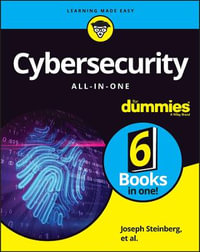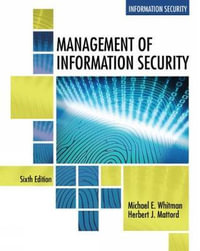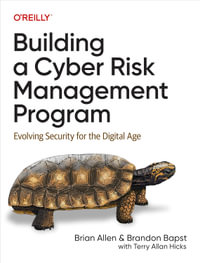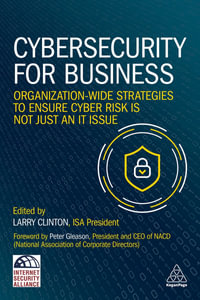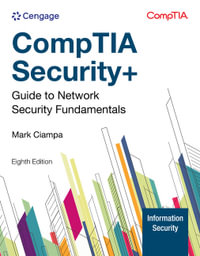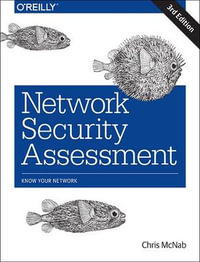
Secure Programming Cookbook for C & C++
By: John Viega, Matt Messier (Contribution by)
Paperback | 25 July 2003
At a Glance
790 Pages
14 x 10.5 x 4.5
Paperback
RRP $142.50
$62.25
56%OFF
or 4 interest-free payments of $15.56 with
orThe Secure Programming Cookbook for C and C++ is an important new resource for developers serious about writing secure code. It contains a wealth of solutions to problems faced by those who care about the security of their applications. It covers a wide range of topics, including safe initialization, access control, input validation, symmetric and public key cryptography, cryptographic hashes and MACs, authentication and key exchange, PKI, random numbers, and anti-tampering. The rich set of code samples provided in the book's more than 200 recipes will help programmers secure the C and C++ programs they write for both Unix (including Linux) and Windows environments. Readers will learn: how to avoid common programming errors, such as buffer overflows, race conditions and format string problems; how to properly SSL-enable applications; how to create secure channels for client-server communication without SSL; how to integrate Public Key Infrastructure (PKI) into applications; best practices for using cryptography properly; techniques and strategies for properly validating input to programs; how to launch programs securely; how to use file access mechanisms properly; and techniques for protecting applications from reverse engineering. The book's Web site supplements the book by providing a place to post new recipes, including those written in additional languages like Perl, Java, and Python. Monthly prizes will reward the best recipes submitted by readers.
Industry Reviews
| Foreword | p. xiii |
| Preface | p. xvii |
| Safe Initialization | p. 1 |
| Sanitizing the Environment | p. 1 |
| Restricting Privileges on Windows | p. 7 |
| Dropping Privileges in setuid Programs | p. 16 |
| Limiting Risk with Privilege Separation | p. 20 |
| Managing File Descriptors Safely | p. 23 |
| Creating a Child Process Securely | p. 26 |
| Executing External Programs Securely | p. 28 |
| Executing External Programs Securely | p. 33 |
| Disabling Memory Dumps in the Event of a Crash | p. 35 |
| Access Control | p. 38 |
| Understanding the Unix Access Control Model | p. 38 |
| Understanding the Windows Access Control Model | p. 41 |
| Determining Whether a User Has Access to a File on Unix | p. 43 |
| Determining Whether a Directory Is Secure | p. 45 |
| Erasing Files Securely | p. 47 |
| Accessing File Information Securely | p. 53 |
| Restricting Access Permissions for New Files on Unix | p. 55 |
| Locking Files | p. 57 |
| Synchronizing Resource Access Across Processes on Unix | p. 60 |
| Synchronizing Resource Access Across Processes on Windows | p. 63 |
| Creating Files for Temporary Use | p. 65 |
| Restricting Filesystem Access on Unix | p. 68 |
| Restricting Filesystem and Network Access on FreeBSD | p. 69 |
| Input Validation | p. 71 |
| Understanding Basic Data Validation Techniques | p. 71 |
| Preventing Attacks on Formatting Functions | p. 75 |
| Preventing Buffer Overflows | p. 78 |
| Using the SafeStr Library | p. 85 |
| Preventing Integer Coercion and Wrap-Around Problems | p. 88 |
| Using Environment Variables Securely | p. 92 |
| Validating Filenames and Paths | p. 97 |
| Evaluating URL Encodings | p. 99 |
| Validating Email Addresses | p. 101 |
| Preventing Cross-Site Scripting | p. 103 |
| Preventing SQL Injection Attacks | p. 107 |
| Detecting Illegal UTF-8 Characters | p. 110 |
| Preventing File Descriptor Overflows When Using select() | p. 112 |
| Symmetric Cryptography Fundamentals | p. 116 |
| Representing Keys for Use in Cryptographic Algorithms | p. 117 |
| Generating Random Symmetric Keys | p. 119 |
| Representing Binary Keys (or Other Raw Data) as Hexadecimal | p. 120 |
| Turning ASCII Hex Keys (or Other ASCII Hex Data) into Binary | p. 121 |
| Performing Base64 Encoding | p. 123 |
| Performing Base64 Decoding | p. 125 |
| Representing Keys (or Other Binary Data) as English Text | p. 128 |
| Converting Text Keys to Binary Keys | p. 130 |
| Using Salts, Nonces, and Initialization Vectors | p. 133 |
| Deriving Symmetric Keys from a Password | p. 136 |
| Algorithmically Generating Symmetric Keys from One Base Secret | p. 141 |
| Encrypting in a Single Reduced Character Set | p. 146 |
| Managing Key Material Securely | p. 149 |
| Timing Cryptographic Primitives | p. 150 |
| Symmetric Encryption | p. 155 |
| Deciding Whether to Use Multiple Encryption Algorithms | p. 155 |
| Figuring Out Which Encryption Algorithm Is Best | p. 156 |
| Selecting an Appropriate Key Length | p. 160 |
| Selecting a Cipher Mode | p. 162 |
| Using a Raw Block Cipher | p. 171 |
| Using a Generic CBC Mode Implementation | p. 175 |
| Using a Generic CFB Mode Implementation | p. 186 |
| Using a Generic OFB Mode Implementation | p. 192 |
| Using a Generic CTR Mode Implementation | p. 197 |
| Using CWC Mode | p. 202 |
| Manually Adding and Checking Cipher Padding | p. 205 |
| Precomputing Keystream in OFB, CTR, CCM, or CWC Modes (or with Stream Ciphers) | p. 207 |
| Parallelizing Encryption and Decryption in Modes That Allow It (Without Breaking Compatibility) | p. 208 |
| Parallelizing Encryption and Decryption in Arbitrary Modes (Breaking Compatibility) | p. 212 |
| Performing File or Disk Encryption | p. 213 |
| Using a High-Level, Error-Resistant Encryption and Decryption API | p. 217 |
| Performing Block Cipher Setup (for CBC, CFB, OFB, and ECB Modes) in OpenSSL | p. 221 |
| Using Variable Key-Length Ciphers in OpenSSL | p. 226 |
| Disabling Cipher Padding in OpenSSL in CBC Mode | p. 227 |
| Performing Additional Cipher Setup in OpenSSL | p. 228 |
| Querying Cipher Configuration Properties in OpenSSL | p. 229 |
| Performing Low-Level Encryption and Decryption with OpenSSL | p. 230 |
| Setting Up and Using RC4 | p. 233 |
| Using One-Time Pads | p. 236 |
| Using Symmetric Encryption with Microsoft's CryptoAPI | p. 237 |
| Creating a CryptoAPI Key Object from Raw Key Data | p. 244 |
| Extracting Raw Key Data from a CryptoAPI Key Object | p. 246 |
| Hashes and Message Authentication | p. 249 |
| Understanding the Basics of Hashes and MACs | p. 249 |
| Deciding Whether to Support Multiple Message Digests or MACs | p. 253 |
| Choosing a Cryptographic Hash Algorithm | p. 254 |
| Choosing a Message Authentication Code | p. 258 |
| Incrementally Hasing Data | p. 262 |
| Hashing a Single String | p. 267 |
| Using a Cryptographic Hash | p. 269 |
| Using a Nonce to Protect Against Birthday Attacks | p. 270 |
| Checking Message Integrity | p. 274 |
| Using HMAC | p. 276 |
| Using OMAC (a Simple Block Cipher-Based MAC) | p. 280 |
| Using HMAC or OMAC with a Nonce | p. 285 |
| Using a MAC That's Reasonably Fast in Software and Hardware | p. 286 |
| Using a MAC That's Optimized for Software Speed | p. 287 |
| Constructing a Hash Function from a Block Cipher | p. 291 |
| Using a Block Cipher to Build a Full-Strength Hash Function | p. 294 |
| Using Smaller MAC Tags | p. 298 |
| Making Encryption and Message Integrity Work Together | p. 298 |
| Making Your Own MAC | p. 300 |
| Encrypting with a Hash Function | p. 301 |
| Securely Authenticating a MAC (Thwarting Capture Replay Attacks) | p. 303 |
| Parallelizing MACs | p. 304 |
| Public Key Cryptography | p. 307 |
| Determining When to Use Public Key Cryptography | p. 309 |
| Selecting a Public Key Algorithm | p. 311 |
| Selecting Public Key Sizes | p. 312 |
| Manipulating Big Numbers | p. 315 |
| Generating a Prime Number (Testing for Primality) | p. 323 |
| Generating an RSA Key Pair | p. 327 |
| Disentangling the Public and Private Keys in OpenSSL | p. 329 |
| Converting Binary Strings to Integers for Use with RSA | p. 330 |
| Converting Integers into Binary Strings for Use with RSA | p. 331 |
| Performing Raw Encryption with an RSA Public Key | p. 332 |
| Performing Raw Decryption Using an RSA Private Key | p. 336 |
| Signing Data Using an RSA Private Key | p. 338 |
| Verifying Signed Data Using an RSA Public Key | p. 340 |
| Securely Signing and Encrypting with RSA | p. 343 |
| Using the Digital Signature Algorithm (DSA) | p. 347 |
| Representing Public Keys and Certificates in Binary (DER Encoding) | p. 352 |
| Representing Keys and Certificates in Plaintext (PEM Encoding) | p. 355 |
| Authentication and Key Exchange | p. 362 |
| Choosing an Authentication Method | p. 362 |
| Getting User and Group Information on Unix | p. 372 |
| Getting User and Group Information on Windows | p. 375 |
| Restricting Access Based on Hostname or IP Address | p. 379 |
| Generating Random Passwords and Passphrases | p. 387 |
| Testing the Strength of Passwords | p. 391 |
| Prompting for a Password | p. 392 |
| Throttling Failed Authentication Attempts | p. 398 |
| Performing Password-Based Authentication with crypt() | p. 400 |
| Performing Password-Based Authentication with MD5-MCF | p. 402 |
| Performing Password-Based Authentication with PBKDF2 | p. 408 |
| Authenticating with PAM | p. 411 |
| Authenticating with Kerberos | p. 414 |
| Authenticating with HTTP Cookies | p. 419 |
| Performing Password-Based Authentication and Key Exchange | p. 422 |
| Performing Authenticated Key Exchange Using RSA | p. 429 |
| Using Basic Diffie-Hellman Key Agreement | p. 432 |
| Using Diffie-Hellman and DSA Together | p. 436 |
| Minimizing the Window of Vulnerability When Authenticating Without a PKI | p. 438 |
| Providing Forward Secrecy in a Symmetric System | p. 444 |
| Ensuring Forward Secrecy in a Public Key System | p. 445 |
| Confirming Requests via Email | p. 447 |
| Networking | p. 454 |
| Creating an SSL Client | p. 455 |
| Creating an SSL Server | p. 457 |
| Using Session Caching to Make SSL Servers More Efficient | p. 460 |
| Securing Web Communication on Windows Using the WinInet API | p. 463 |
| Enabling SSL without Modifying Source Code | p. 468 |
| Using Kerberos Encryption | p. 470 |
| Performing Interprocess Communication Using Sockets | p. 475 |
| Performing Authentication with Unix Domain Sockets | p. 482 |
| Performing Session ID Management | p. 486 |
| Securing Database Connections | p. 487 |
| Using a Virtual Private Network to Secure Network Connections | p. 490 |
| Building an Authenticated Secure Channel Without SSL | p. 491 |
| Public Key Infrastructure | p. 502 |
| Understanding Public Key Infrastructure (PKI) | p. 502 |
| Obtaining a Certificate | p. 513 |
| Using Root Certificates | p. 519 |
| Understanding X.509 Certificate Verification Methodology | p. 522 |
| Performing X.509 Certificate Verification with OpenSSL | p. 525 |
| Performing X.509 Certificate Verification with CryptoAPI | p. 530 |
| Verifying an SSL Peer's Certificate | p. 535 |
| Adding Hostname Checking to Certificate Verification | p. 539 |
| Using a Whitelist to Verify Certificates | p. 544 |
| Obtaining Certificate Revocation Lists with OpenSSL | p. 547 |
| Obtaining CRLs with CryptoAPI | p. 556 |
| Checking Revocation Status via OCSP with OpenSSL | p. 562 |
| Random Numbers | p. 568 |
| Determining What Kind of Random Numbers to Use | p. 568 |
| Using a Generic API for Randomness and Entropy | p. 573 |
| Using the Standard Unix Randomness Infrastructure | p. 575 |
| Using the Standard Windows Randomness Infrastructure | p. 580 |
| Using an Application-Level Generator | p. 581 |
| Reseeding a Pseudo-Random Number Generator | p. 591 |
| Using an Entropy Gathering Daemon--Compatible Solution | p. 594 |
| Getting Entropy or Pseudo-Randomness Using EGADS | p. 599 |
| Using the OpenSSL Random Number API | p. 603 |
| Getting Random Integers | p. 605 |
| Getting a Random Integer in a Range | p. 606 |
| Getting a Random Floating-Point Value with Uniform Distribution | p. 608 |
| Getting Floating-Point Values with Nonuniform Distributions | p. 609 |
| Getting a Random Printable ASCII String | p. 611 |
| Shuffling Fairly | p. 612 |
| Compressing Data with Entropy into a Fixed-Size Seed | p. 613 |
| Getting Entropy at Startup | p. 614 |
| Statistically Testing Random Numbers | p. 615 |
| Performing Entropy Estimation and Management | p. 621 |
| Gathering Entropy from the Keyboard | p. 630 |
| Gathering Entropy from Mouse Events on Windows | p. 638 |
| Gathering Entropy from Thread Timings | p. 643 |
| Gathering Entropy from System State | p. 644 |
| Anti-Tampering | p. 647 |
| Understanding the Problem of Software Protection | p. 648 |
| Detecting Modification | p. 653 |
| Obfuscating Code | p. 658 |
| Performing Bit and Byte Obfuscation | p. 664 |
| Performing Constant Transforms on Variables | p. 667 |
| Merging Scalar Variables | p. 667 |
| Splitting Variables | p. 669 |
| Disguising Boolean Values | p. 670 |
| Using Function Pointers | p. 671 |
| Restructuring Arrays | p. 672 |
| Hiding Strings | p. 678 |
| Detecting Debuggers | p. 681 |
| Detecting Unix Debuggers | p. 682 |
| Detecting Windows Debuggers | p. 685 |
| Detecting SoftICE | p. 685 |
| Countering Disassembly | p. 688 |
| Using Self-Modifying Code | p. 693 |
| Other Topics | p. 700 |
| Performing Error Handling | p. 700 |
| Erasing Data from Memory Securely | p. 704 |
| Preventing Memory from Being Paged to Disk | p. 707 |
| Using Variable Arguments Properly | p. 709 |
| Performing Proper Signal Handling | p. 712 |
| Protecting against Shatter Attacks on Windows | p. 716 |
| Guarding Against Spawning Too Many Threads | p. 718 |
| Guarding Against Creating Too Many Network Sockets | p. 724 |
| Guarding Against Resource Starvation Attacks on Unix | p. 727 |
| Guarding Against Resource Starvation Attacks on Windows | p. 730 |
| Following Best Practices for Audit Logging | p. 734 |
| Index | p. 739 |
| Table of Contents provided by Ingram. All Rights Reserved. |
ISBN: 9780596003944
ISBN-10: 0596003943
Series: Cookbooks Ser.
Published: 25th July 2003
Format: Paperback
Language: English
Number of Pages: 790
Audience: Professional and Scholarly
Publisher: O'Reilly Media, Inc, USA
Country of Publication: US
Dimensions (cm): 14 x 10.5 x 4.5
Weight (kg): 1.37
Shipping
| Standard Shipping | Express Shipping | |
|---|---|---|
| Metro postcodes: | $9.99 | $14.95 |
| Regional postcodes: | $9.99 | $14.95 |
| Rural postcodes: | $9.99 | $14.95 |
How to return your order
At Booktopia, we offer hassle-free returns in accordance with our returns policy. If you wish to return an item, please get in touch with Booktopia Customer Care.
Additional postage charges may be applicable.
Defective items
If there is a problem with any of the items received for your order then the Booktopia Customer Care team is ready to assist you.
For more info please visit our Help Centre.
You Can Find This Book In

Cloud Native Application Protection Platforms
A Guide to Cnapps and the Foundations of Comprehensive Cloud Security
Paperback
RRP $125.50
$55.25
OFF

BLACK FRIDAY
RRP $40.80
$10.25
OFF
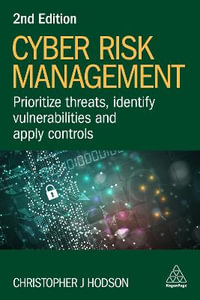
BLACK FRIDAY
RRP $108.00
$54.00
OFF
This product is categorised by
- Non-FictionComputing & I.T.Computer Programming & Software DevelopmentObject-Oriented Programming or OOP
- Non-FictionComputing & I.T.Computer Programming & Software DevelopmentProgramming & Scripting Languages
- Non-FictionComputing & I.T.Computer SecurityData Encryption
- Non-FictionComputing & I.T.Computer Networking & CommunicationsNetwork Security





